Last updated: 1 October 2007
|
Last updated: 1 October 2007 |
This review was originally published on 18 October 2006. Effective 1 October 2007, the StarLink was discontinued and is no longer available.
StarLink Bluetooth Wireless Module
from PixSoft Inc.
$69 (with custom power cable for Meade ETX/LXD/LX90, Meade LX200/RCX400, Celestron* or Losmandy Gemini)
$49 (if you already have a StarGPS)
* available soon
From the StarGPS company, you can now add BlueTooth wireless control to your telescope. This is a similar product to the Orion BlueStar Wireless Adapter ($149) and the AstroCables Bluetooth Wireless Telescope Control Kit for Meade/Celestron ($78) but at a lower price. StarGPS sent me an evaluation unit and I tested it using an Apple Powerbook 17" with built-in Bluetooth running Mac OS X 10.4.8.
The StarLink is a small device that connects to the telescope's AUX port (for power) and to the AutoStar (or other controller). Here you can see the StarLink, and its AutoStar #497 cable (and an AutoStar #497 for size comparison).
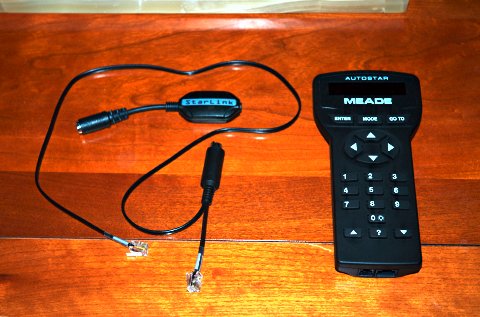
Here's a closeup of just the StarLink module.
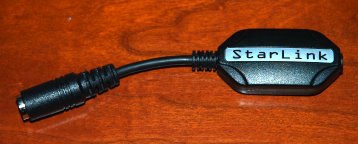
And here you can see the StarLink (on the right) connected to my ETX-125 via the AUX port and to the AutoStar. [For comparison, the LX200 adapter cable is only 6" long and plugs into the RS232 port for power and data. See http://www.stargps.ca/cables.htm#gps-lx200.]
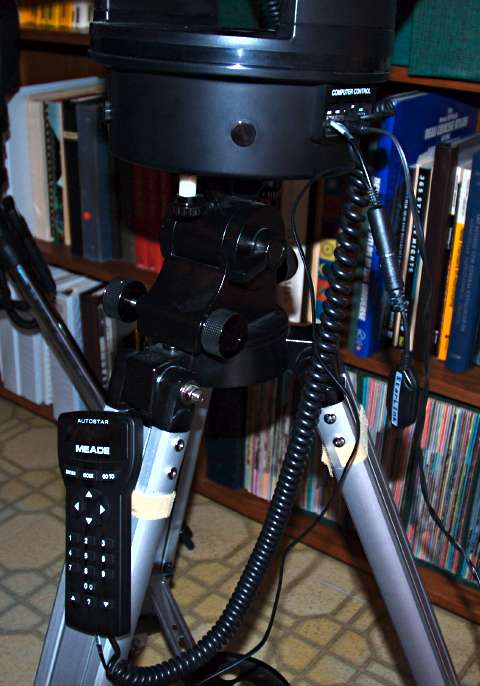
Following the instructions on the StarGPS site I powered on the ETX and started to go through the normal Alignment steps. That's when I discovered a minor hiccup; as soon as I got to the Align step the ETX began slewing to the right in Azimuth and would have continued to slew until it hit the hard stop. I powered off the ETX and tried again. Same problem. I then went through the AutoStar menu tree until I got to CALIBRATE MOTOR. Once I did that the ETX performed as expected and did not begin to slew at the Alignment step. While I can't say for certain, I suspect the StarLink drew just enough extra power, minimal though it may be, from the ETX that the readings from the encoders were significantly different from the last time I did a CALIBRATE MOTOR. So, if you experience the same problem just do a CALIBRATE MOTOR to clear it up.
Once I aligned the AutoStar I went to my computer and setup the Bluetooth device. The StarGPS site includes instructions for a PC, Windows Mobile/Pocket PC, and a Palm PDA. The setup on Mac OS X is very straight forward; just select "Set up Bluetooth Device..." from the Bluetooth icon in the menu bar (or use the Bluetooth System Preferences panel). When the setup assistance discovers the StarLink you will be prompted to enter a passkey ("0000") as seen here:
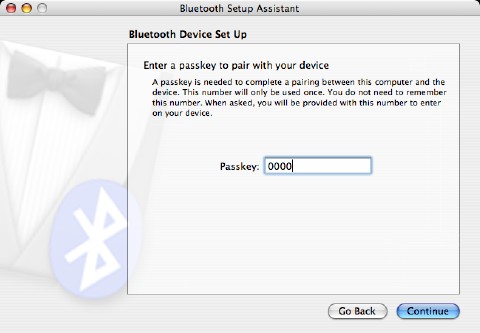
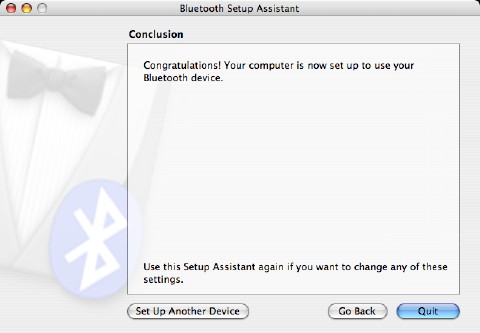
This will complete the steps to use the StarLink with your Apple computer.
I then fired up AstroPlanner and configured it to use the StarLink (from the Serial Port popup menu:

I was then able to control the ETX using AstroPlanner, slewing manually using its control panel or by selecting an object in AstroPlanner and telling it to GOTO that object. Here you can see (in this reduced scale image) that I have selected the star Alpha Andromeda and selected to slew to it; the slew is shown in progress and indeed the telescope slewed. The StarLink has a faint red LED to indicate its status so you will always know whether it is working.

I quit AstroPlanner and launched Voyager III and configured it to use the StarLink:

I was then able to control the ETX using Voyager. StarLink control should work with any telescope control software that would otherwise use a serial port connection.
If you keep your telescope and computer within several feet of each other (the spec says up to about 30 feet) then you shouldn't have any problems using Bluetooth to control the telescope. But keep in mind that the effective distance has many variables, including the type of Bluetooth transmitter, the antenna used in the computer (or outside the computer), and anything that could cause interference or block the signal.
If you use a computer with your telescope, having wireless control over your telescope means one less cable connection to worry about. This could be important since a cable from the telescope to the computer is likely to be invisible in the dark, creating a danger of knocking a computer (and/or the telescope) to the ground. If your computer already has Bluetooth (or if you add a Bluetooth module to it), then using one of the Bluetooth telescope control devices can make using the computer at the telescope potentially safer and seamless. The StarLink functions as expected and comes at a lower price than the other two devices currently on the market.
As with the StarGPS, if you want to automate and computer-control your telescope, the StarLink is a worthwhile addition. [Note: the StarGPS and the StarLink can not be used at the same time. This is not a big problem as you can disconnect the StarGPS after alignment and connect the StarLink without powering off the telescope.]
Return to the top of this page.
Go back to the ETX Home Page.